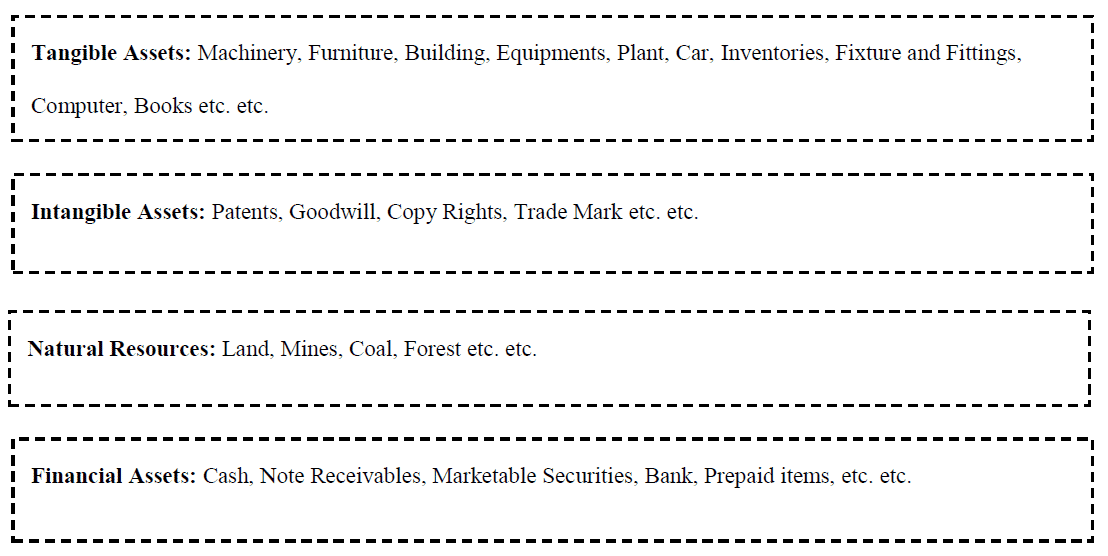Assets
Previous Lesson: Types of Accounts
Next Lesson: Current Assets
Assets can be thought of as the things you own, the things you have rights to, and expenses that have been paid for and have not yet been used up. The things a company owns include cash, investments, inventory, land, buildings, equipment, vehicles, furniture, and fixtures. Assets that represent items the company have rights to include licenses, trademarks, copyrights, and franchises.
Assets represent an expense that has been paid for and not yet used up is a prepaid expense. Assets are often divided into current and noncurrent (sometimes called long-term).
Current assets are those assets that are expected to be turned into cash or used up within the next twelve months. Typical current assets are cash, accounts receivable, inventory, marketable securities, and prepaid expenses. Noncurrent assets are those assets that are not going to be turned into cash or used up within the next twelve months.
Assets are defined as, “a resource controlled by the entity as a result of past events and from which future economic benefits are expected to flow to the entity”.
To understand this definition fully, each phrase must be analyze separately as below:
- Controlled by entity
- Past events
- Future economic benefits
>>> Read Current Assets
Examples of Assets
The following items are commonly found in the assets section of balance sheet of a company:
- Plant and machinery owned
- Land and buildings owned
- Land and buildings leased
- Vehicles
- Inventory/Stock
- Raw materials
- Work in progress
- Finished goods
- Account receivables
- Prepaid insurance and rentals
- Investments in shares of other companies (Marketable Securities)
- Cash held in a bank account.
As noted above, assets are resources a business owns. The business uses its assets in carrying out such activities as production and sales. The common characteristic possessed by all assets is the capacity to provide future services or benefits. In a business, that service potential or future economic benefit eventually results in cash inflows (receipts).
>>> Read Types of Accounts.
Types of Assets
It has four types, Tangible Assets, Intangible Assets, Natural Resources and Financial Assets.
Current Assets and Non-Current Assets
It is conventional practice to separate assets into current assets and non-current assets. Current assets are held with the intention of converting them into cash within the business cycle. Non-current assets, also called fixed assets, are held for continuing use in the business. The business cycle is the period (usually 12 months) during which the peaks and troughs of activity of a business form a pattern which is repeated on a regular basis.
Recognition of Assets
When an item has passed the tests of definition of an asset, it has still not acquired the right to a place in the statement of financial position (balance sheet). To do so it must meet further tests of recognition. Recognition means reporting an item by means of words and amounts within the main financial statements in such a way that the item is included in the arithmetic totals. An item which is reported in the notes to the accounts is said to be disclosed but not recognized. The conditions for recognition have been expressed as in the following definition.
An asset is recognized in the statement of financial position (balance sheet) when: it is probable that the future economic benefits will flow to the entity and the asset has a cost or value that can be measured reliably.
>> Read Cash Book.
References
Mukharji, A., & Hanif, M. (2003). Financial Accounting (Vol. 1). New Delhi: Tata McGraw-Hill Publishing Co.
Narayanswami, R. (2008). Financial Accounting: A Managerial Perspective. (3rd, Ed.) New Delhi: Prentice Hall of India.
Ramchandran, N., & Kakani, R. K. (2007). Financial Accounting for Management. (2nd, Ed.) New Delhi: Tata McGraw Hill.


This is very interesting, You’re a very skilled blogger.